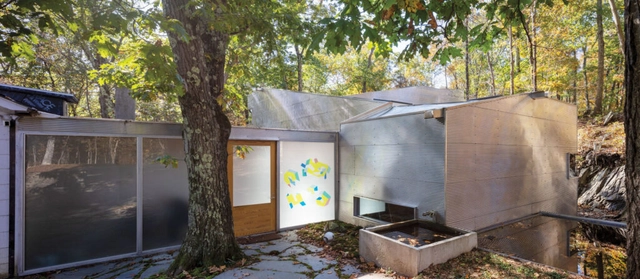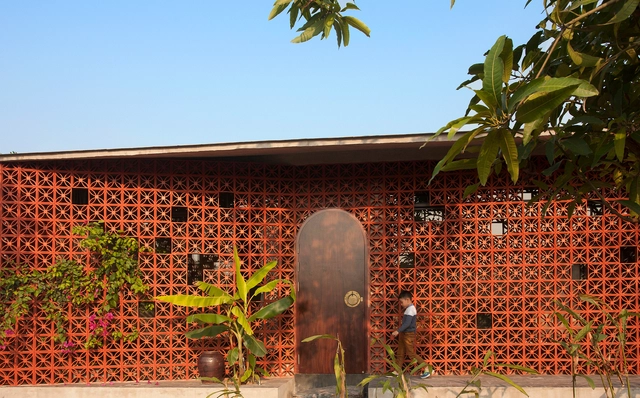A step-by-step outline on how to turn 3D models in SketchUp into 2D documentation through LayOut.
News
Generating Documentation With SketchUp
Returning the Building to the Soil: an Interview with the Architect and Scientist Mae-Ling Lokko

Agriculture and the food industry seem to have little in common with architecture, but it is precisely the overlap of these three areas that interests Ghanaian-Filipino scientist and architect Mae-ling Lokko, founder of Willow Technologies based in Accra, Ghana. Working with recycling agricultural waste and biopolymer materials, Lokko searches for ways to transform the so-called agrowaste into building materials.
How Does Global Inflation Impact the Design Profession?

Architecture, as a profession, is highly cyclical in nature. It ebbs and flows with the tides of economic conditions, and is especially hard hit during times of downturn. We’ve all heard stories or experienced it ourselves, or layoffs during the Great Financial Crisis in 2008, or even more recently the significant cutbacks architecture firms went through during the uncertainty of the COVID-19 pandemic. Projects went on hold and new business opportunities declined almost overnight. Now, two years later, firms are keeping a close watch on global supply chain issues and rising inflation rates, especially with increased pressure to meet the needs of a growing urban population. Will architecture be recession-proof as we enter a bear market?
Steven Holl’s Architectural Archive Preserves His Firm’s Designs and the Landscape

Steven Holl can often be found reading poetry and painting watercolors in a tiny cabin overlooking lotus flowers on the edge of a lake in Rhinebeck, New York. The cabin sits on a 28-acre reserve that Holl purchased in 2014 that now hosts Holl’s full-time office, and ‘T’ Space, a nonprofit arts organization offering creative exhibitions, environmental installations, and architectural residencies. Wrapping around several large trees and linking through a passageway to another existing 1959 cabin, the Steven Myron Holl Foundation’s Architectural Archive and Research Library, built in 2019, is the latest building to be carefully situated in the lush landscape.
The Highly Anticipated SketchUp for iPad App is Here
Now, more than ever, architects are working outside the office. Whether meeting with a client over Zoom, visiting a job site, or sketching on the train, design professionals aren’t tethered to their desks– and neither should their 3D tools.
SketchUp, one of the most popular 3D modelers in the world, set out to meet this “new normal” for designers by launching a new mobile app: SketchUp for iPad. With a simple UI, intuitive drawing tools, and a direct integration with the cloud collaboration platform, Trimble Connect, SketchUp for iPad empowers designers to work in 3D anywhere. Let’s take a closer look.
On Inclusive, Safe, Resilient, and Sustainable Cities: In Conversation with the Winners of the UIA 2030 Award

The first edition of the UIA 2030 Award celebrated projects that contribute to the delivery of the UN 2030 Agenda for Sustainable Development. Located in Germany, Hong Kong, Argentina, Bangladesh, and China, the winning interventions were announced during the eleventh session of the World Urban Forum in Katowice, Poland. Organized by the International Union of Architects (UIA), together with the UN-HABITAT, the award program gathered 125 submissions in 40 countries.
ArchDaily had the chance to talk to the winners behind the acclaimed architecture, to discuss furthermore the interventions and certain specificities of each and every project. In addition, the winning teams shared their upcoming and ongoing architectural endeavors as well as their point of view on the importance of architects engaging with the Sustainable Development Goals.
The Maldives is Combating Rising Sea Levels with Auto-Responsive Floating City

Netherlands-based architecture, urban planning, and research firm Waterstudio.NL in collaboration with Dutch Docklands and the Government of The Maldives have revealed the design of Maldives Floating City (MFC), a first-of-its-kind “island city” that offers a new approach to modern sustainable living on the Indian Ocean. The project has been in development for over a decade, and will feature thousands of residences, floating along a flexible, functional grid across a 200-hectare lagoon.
Steven Holl's Chapel of St. Ignatius in Seattle Receives AIA's Twenty-Five Year Award
.jpg?1656484624&format=webp&width=640&height=580)
The Chapel of St. Ignatius in Seattle, designed by Steven Holl Architects, has been honored by the American Institute of Architects (AIA) with its Twenty-five Year Award. AIA’s award is conferred on a building that has set a precedent, stood the test of time for 25 to 35 years and continues to set standards of excellence for its architectural design and significance. The Chapel of St. Ignatius finished in 1997, reflects the ideal of the Jesuit practice, a religious order of the Catholic Church, in which no single method of worship is prescribed. Instead, the sect recognizes that “different methods helped different people.” That idea is reflected in the Chapel of St. Ignatius, Seattle University’s main chapel, where differences in light unify to support the worship and ritual needs of the university community.
Transforming Clay Into Structure: How Ceramics Are Used in Construction

Ceramic fragments and figures found at the Neolithic site of Mureybet, in Syria's Middle Euphrates valley, indicate that clay and fire work date back to the 7th millennium BC. This means that dealing with ceramics is one of the oldest activities in human history. More than 9,000 years later, ceramic, and all its derivatives, has become one of the most used materials in construction, being used at different times, from structure to finishes.
Crafting for Contemplation: The Minimal vs. The Ornamental

A few weeks ago, this year’s edition of the Serpentine Pavilion opened to the public. Designed by Chicago-based artist Theaster Gates, it’s an evocative project, its cylindrical form referencing American beehive kilns, English bottle kilns, and Musgum adobe homes found in Cameroon.
What the pavilion is named tells the viewer a lot more about its intentions as a spatial experience. Titled Black Chapel, it houses a spacious room with wraparound benches, and an oculus above that allows daylight to filter into the space. It’s a fairly minimal interior – designed as a site for contemplation and reflection. This minimal quality of Gates’ Serpentine Pavilion raises particularly interesting questions. How artists and architects opt for a “less is more” approach when designing meditative spaces, but also how these introspective spaces have been equally enhanced by ornamentation.
A' Design Awards & Competition 2022 - Early Call for Entries

The A’ Design Award was "born out of the desire to underline the best designs and well-designed products." It is an international award whose aim is to provide designers, architects, and innovators from all design fields with a platform to showcase their work and products to a global audience. This year's edition is now open for early entries; designers can register their submissions here.
When Vintage Meets Modern: 5 Barn Lights That Achieve a Contemporary Aesthetic

Characterized by a simple structure and a gable roof, the traditional barnyard typology responds to its original function: sheltering farm products and livestock. In recent years, however, the barn aesthetic has evolved tremendously, sparking the interest of designers with its enduring rustic charm, minimalistic shape, refined ornamentation and modularity – qualities that have long made it popular in countryside hideaways. Reinterpreted to fit a contemporary style, the vintage typology has conquered modern projects that seek to offer an escape from the fast-paced, dense reality of urban life. Whether refurbishing historic farms or building new homes designed to resemble barns, architects have drawn inspiration from the industrial origins of traditional barnyards, but adding a modern twist.
Children’s Square Iguatemi _ mk27 / studio mk27

A square as a ludic space for children to freely explore – this was the idea behind the project for the Children Square Iguatemi, which will be built shortly on a site of 900 m², in the midst of a residential area.
Winners of the UIA 2030 Award Announced: Acknowledging Architects' Contributions to the Sustainable Development Goals

Today, at the eleventh session of the World Urban Forum in Katowice, Poland, the International Union of Architects (UIA), together with the UN-HABITAT, have announced the laureates of the UIA 2030 Award. Seeking to acknowledge the contributions of architects to the UN 2030 Agenda for Sustainable Development and New Urban Agenda through built interventions that demonstrate design quality and alignment with the UN Sustainable Development Goals (SDGs), this first edition of a biennial awards program, selected winning projects from Germany, Hong Kong, Argentina, Bangladesh, and China, from 125 submitted projects in 40 countries.
Organized under six categories: Open Category, Improving Energy Efficiency, Adequate, Safe & Affordable Housing, Participatory, Land-Use Efficient & Inclusive Planning, Access to Green & Public Space, and Utilizing Local Materials, the jurors picked a winner per section, yet were unable to identify an overall winner in the open category and chose instead to recognize six projects as Highly Commended, honoring in total 5 laureates and 15 commendations.
Homomonument: The Importance of a Representative Space in the City

While walking through the city, have you ever felt afraid to be yourself? As strange as the question may sound to some, it is a reality for most LGBTQIA+ people, who at some point have been victims of hostility when they were noticed performing outside the "heteronormative standards" of public spaces. If violence comes from social layers that go beyond the designed space, this does not exempt the importance of thinking about projects that can integrate the physical sphere and insert a symbolic or representational factor to include and educate its citizens. This is the case of Homomonument, which for more than three decades, has become a platform for queer celebration and protest in the heart of Amsterdam.
How Gamification Can Transform Architecture Education

The Age of Digitalization began nearly 40 years ago with the rise of information technology. With it came massive changes in the way humans interacted and industries operated — that is, with the exception of the education field. For the longest time, in spite of continuously evolving technologies around us, classroom learning remained the same. A teacher stood addressing students, imparting knowledge through conventional methods of reading, orating, and chalkboard drawing. This has also been true for architecture education so far. But times are changing. Today’s students have grown up with digital technologies around them and therefore can benefit from new learning methods, such as gamification, to challenge their intellects.
Heatherwick Studio Unveils Crown-Shaped Kinetic Glasshouse in West Sussex

Heatherwick Studio, in collaboration with The Woolbeding Charity and the National Trust, have unveiled their latest project, a kinetic Glasshouse and Silk Route Garden set on the edge of Woolbeding Gardens, a historic estate in West Sussex. The unfolding structure serves as a focal point to a new garden that highlights how ancient Silk Route has influenced English gardens of today. The structure features ten steel ‘sepals’ with a glass and aluminum façade, which creates a 141 sqm space in the shape of a crown once it opens.
Powerhouse Company, Atelier Oslo and Lundhagem Win the Competition for the Rotterdam Central Library

The City of Rotterdam has selected Powerhouse Company, Atelier Oslo, Lundhagem to renew and extend the city’s Central Library, a landmark building from the early 1980s designed by Van den Broek & Bakema. The new design adopts the concept of radical reuse in order to transform a 1980s building into a contemporary library, well-adapted to the necessities of modern users. The team combines the expertise of Powerhouse Company, Atelier Oslo, and Lundhagem, the latter two offices being awarded in 2021 with the Public Library of the Year Award for their design of Oslo!s Deichman library. Construction is expected to begin in 2025 and be completed by the end of 2028, the year marking the building!s 45th anniversary.
How Bicycles Empowered Women to Occupy Public Spaces

“Let me tell you what I think of the bicycle. It has done more to emancipate women than anything else in the world. It gives women a sense of freedom and self-confidence. I appreciate every time I see a woman cycling... an image of freedom”. Susan Anthony, one of the most important American suffragette leaders, said this at the beginning of the 20th century, praising the libertarian power represented by women and their bicycles at the time.
The Envelope's Role in Net-Zero or Positive Buildings

In the face of increasingly alarming predictions regarding the climate crisis, just increasing the efficiency of buildings is no longer enough. Zero energy buildings - or, better yet, energy positive buildings - make it possible to mitigate the negative impacts of the construction industry, which is responsible for 40% of all greenhouse gas emissions. These are buildings capable of producing more energy than they consume through the use of renewable sources. To reach this ambitious goal, it is necessary to follow three main steps:
-
Install a renewable power system to provide clean energy;
-
Include high efficiency systems, such as climatization equipment and low energy lighting.
-
Improve the construction envelope to conserve energy and reduce loads.
Bruzzano Urban Market: A YACademy Alumni Pavilion for the Milan Suburbs

Suburbs are one of the favorite fields of action for people who deal with social architecture in “first world” contexts. In 2020, a group of students from the Architecture for Humanity course at YAcademy– the renowned international school of architecture located in Bologna, Italy – had the opportunity to work with Michele De Lucchi in order to bring arts, beauty and quality into the drab suburbs of Milan.
9 Architect-Designed Installations, Products, and Furniture Pieces at the 2022 Fuorisalone

Along with the participation of thousands of designers, artists, and craftsmen at this year's 2022 Salone del Mobile at Milan's Rho Fiera, renowned architects collaborated with some of the biggest local and international manufacturers to create installations, products, materials, and furniture pieces that explore the future of living, as part of the annual Fuorisalone.
This year's architectural contributions, which were on display across the busy streets of Milan, Brera design district and botanical garden, Alcova, BASE, and other cultural venues, highlighted this year's Milan Design Week theme of sustainability and environmental awareness with respect to furniture production.













_Domat.jpg?1656485110)
.jpg?1656485127)













.jpg?1656484650)
.jpg?1656484668)

.jpg?1656484634)
.jpg?1656484624)
















.jpg?1656364895)































